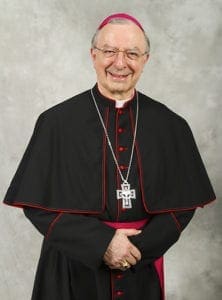Thinking with the church
By BISHOP JOEL M. KONZEN, SM | Published April 1, 2021 | En Español
When he wanted us to have second helpings, my grandfather used to say, “You have two legs. You have to eat for both of them.” These days, when I think of two legs, I don’t think of eating. Instead, I am given to think about being a faithful Catholic and how that requires us to straddle a social and political divide in this nation.

Bishop Joel M. Konzen, SM
On the one hand, we are conscious of the church’s teachings on topics that relate to the sanctity of all life and the natural law that undergirds these teachings: against abortion and euthanasia, in favor of natural family planning, against the choosing of one’s gender and against sexual activity outside of marriage, and in favor of a church-sanctioned marriage as the only valid marriage.
On the other hand, we are bound also to consider our role in sin that is often more social: the need to construct peaceful relations and to reject domestic and civil violence, refusing to support capital punishment, respecting the commitment to aid the earth’s sustaining of its population by healthy means, denouncing racism in any form, seeking just forms of government and economic justice, and being mindful of our responsibility to the poor and the oppressed.
This duality has long been present. The sands may have shifted in the church’s understanding of its responsibilities in some areas, and the platforms of our two main political parties in the United States have undoubtedly shifted as well. But Catholics have long been asked to balance a variety of concerns when examining their consciences across the whole spectrum of areas requiring our adherence and attention. This is why, when we approach the Sacrament of Reconciliation, we should avoid ticking off the list of sins we are used to confessing and, instead, use a thorough listing of the areas that constitute fidelity to the full message of the Gospel of Jesus Christ as maintained by the church today.
The image of the two legs is apt for the situation. One leg alone cannot uphold our Catholic consciousness and obligation. We need them both. When we encounter a teaching that is either inherently challenging or opposed to our personal preference, we do well to learn more about why the Catholic Church has expressed the particular explanation and stance. It is not enough to shake one’s head and plod on in the direction that brings us comfort despite its deviation from the official teaching contained in the Catechism and the documents that expand our understanding of essential truths.
In a very real sense, embracing the totality of the church’s teachings may lead us into a clash between the ego and the more humble approach of the saints. If I maintain that the church “just got it wrong” on its traditional or recent teaching, I am allowing my ego to prevail and to guide me toward a ditch that I want to avoid falling into. The humble approach is to learn more about how I can join my conscience to the mind of the church and thereby enjoy the sense of “thinking with the church”—sentire cum ecclesia in Latin, a goal for all Catholics, even if it is a task for a lifetime.
To rise with Christ on Easter is to know the forgiveness of God and his reconciling with us as sinners who are in a constant process of conversion to the fullness of the teaching we have received through his Son Jesus Christ. May we know the abundant joy that such reconciliation and welcome do bring, as we ask the Holy Spirit to open our hearts ever more completely to the truth of the Gospel.